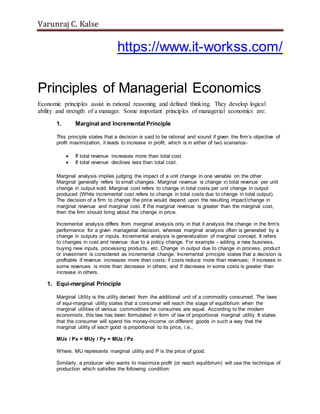
Principles of managerial economics www.it-workss.com
- 1. Varunraj C. Kalse https://www.it-workss.com/ Principles of Managerial Economics Economic principles assist in rational reasoning and defined thinking. They develop logical ability and strength of a manager. Some important principles of managerial economics are: 1. Marginal and Incremental Principle This principle states that a decision is said to be rational and sound if given the firm’s objective of profit maximization, it leads to increase in profit, which is in either of two scenarios- If total revenue increases more than total cost. If total revenue declines less than total cost. Marginal analysis implies judging the impact of a unit change in one variable on the other. Marginal generally refers to small changes. Marginal revenue is change in total revenue per unit change in output sold. Marginal cost refers to change in total costs per unit change in output produced (While incremental cost refers to change in total costs due to change in total output). The decision of a firm to change the price would depend upon the resulting impact/change in marginal revenue and marginal cost. If the marginal revenue is greater than the marginal cost, then the firm should bring about the change in price. Incremental analysis differs from marginal analysis only in that it analysis the change in the firm's performance for a given managerial decision, whereas marginal analysis often is generated by a change in outputs or inputs. Incremental analysis is generalization of marginal concept. It refers to changes in cost and revenue due to a policy change. For example - adding a new business, buying new inputs, processing products, etc. Change in output due to change in process, product or investment is considered as incremental change. Incremental principle states that a decision is profitable if revenue increases more than costs; if costs reduce more than revenues; if increase in some revenues is more than decrease in others; and if decrease in some costs is greater than increase in others. 1. Equi-marginal Principle Marginal Utility is the utility derived from the additional unit of a commodity consumed. The laws of equi-marginal utility states that a consumer will reach the stage of equilibrium when the marginal utilities of various commodities he consumes are equal. According to the modern economists, this law has been formulated in form of law of proportional marginal utility. It states that the consumer will spend his money-income on different goods in such a way that the marginal utility of each good is proportional to its price, i.e., MUx / Px = MUy / Py = MUz / Pz Where, MU represents marginal utility and P is the price of good. Similarly, a producer who wants to maximize profit (or reach equilibrium) will use the technique of production which satisfies the following condition:
- 2. Varunraj C. Kalse MRP1 / MC1 = MRP2 / MC2 = MRP3 / MC3 Where, MRP is marginal revenue product of inputs and MC represents marginal cost. Thus, a manger can make rational decision by allocating/hiring resources in a manner which equalizes the ratio of marginal returns and marginal costs of various use of resources in a specific use. 2. Opportunity Cost Principle By opportunity cost of a decision is meant the sacrifice of alternatives required by that decision. If there are no sacrifices, there is no cost. According to Opportunity cost principle, a firm can hire a factor of production if and only if that factor earns a reward in that occupation/job equal or greater than it’s opportunity cost. Opportunity cost is the minimum price that would be necessary to retain a factor-service in it’s given use. It is also defined as the cost of sacrificed alternatives. For instance, a person chooses to forgo his present lucrative job which offers him Rs.50000 per month, and organizes his own business. The opportunity lost (earning Rs. 50,000) will be the opportunity cost of running his own business. 3. Time Perspective Principle According to this principle, a manger/decision maker should give due emphasis, both to short- term and long-term impact of his decisions, giving apt significance to the different time periods before reaching any decision. Short-run refers to a time period in which some factors are fixed while others are variable. The production can be increased by increasing the quantity of variable factors. While long-run is a time period in which all factors of production can become variable. Entry and exit of seller firms can take place easily. From consumers point of view, short-run refers to a period in which they respond to the changes in price, given the taste and preferences of the consumers, while long-run is a time period in which the consumers have enough time to respond to price changes by varying their tastes and preferences. 4. Discounting Principle According to this principle, if a decision affects costs and revenues in long-run, all those costs and revenues must be discounted to present values before valid comparison of alternatives is possible. This is essential because a rupee worth of money at a future date is not worth a rupee today. Money actually has time value. Discounting can be defined as a process used to transform future dollars into an equivalent number of present dollars. For instance, $1 invested today at 10% interest is equivalent to $1.10 next year. FV = PV*(1+r)t Where, FV is the future value (time at some future time), PV is the present value (value at t0, r is the discount (interest) rate, and t is the time between the future value and present value.
